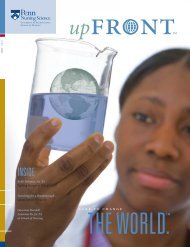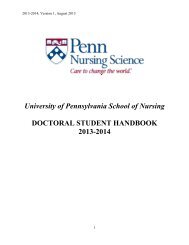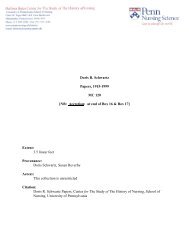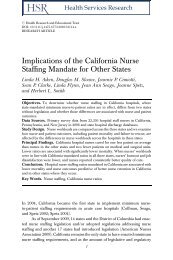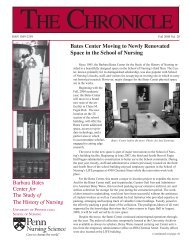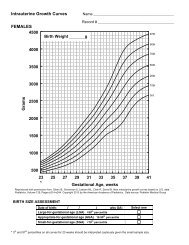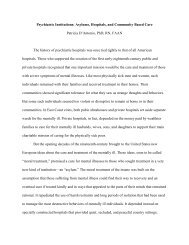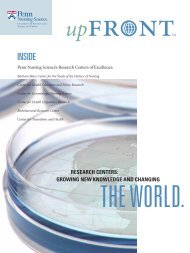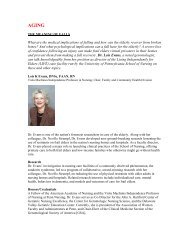10 Landmark Nursing Research Studies - National Institute of ...
10 Landmark Nursing Research Studies - National Institute of ...
10 Landmark Nursing Research Studies - National Institute of ...
You also want an ePaper? Increase the reach of your titles
YUMPU automatically turns print PDFs into web optimized ePapers that Google loves.
<strong>of</strong> the skin to moisture, exposure <strong>of</strong> the skin to friction or shearing<br />
during movement, and the ability to sense and respond to pressurerelated<br />
discomfort. The lower the overall score, the higher the<br />
pressure sore risk.<br />
Dr. Bergstrom tested the Braden scale in a multisite clinical trial<br />
involving tertiary care hospitals, Veterans Administration (VA) medical<br />
centers and skilled nursing facilities. None <strong>of</strong> the participants initially<br />
had pressure sores. Nurses assessed the participants using the Braden<br />
scale every two to three days over one- to four-week periods. During<br />
the study, roughly <strong>10</strong>% <strong>of</strong> the hospital or VA patients, and almost<br />
one-quarter <strong>of</strong> nursing home residents, developed a pressure sore.<br />
Patients with pressure sores were more likely to be older, white, and<br />
female. Findings supported the predictive value <strong>of</strong> the Braden scale<br />
to identify those patients at high risk for pressure sores.<br />
Implications<br />
The Braden scale is now widely used in nursing homes and hospitals<br />
all over the world. Dr. Bergstrom has chaired two panels <strong>of</strong> the<br />
Agency for Health Care Policy and <strong>Research</strong>, now the Agency for<br />
Healthcare <strong>Research</strong> and Quality (AHRQ), to determine best practice<br />
information on pressure sore prevention. Her research and knowledge<br />
about pressure sores was instrumental in writing Pressure Ulcers in<br />
Adults: Prediction and Prevention, and Pressure Ulcer Treatment, from which the<br />
current AHRQ clinical guidelines for prevention and treatment <strong>of</strong><br />
pressure sores were developed.<br />
Reference<br />
Bergstrom N, Braden B, Kemp M, Champagne M, Ruby E. Multi-site<br />
study <strong>of</strong> incidence <strong>of</strong> pressure ulcers and the relationship between risk level,<br />
demographic characteristics, diagnoses, and prescription <strong>of</strong> preventive<br />
interventions. Journal <strong>of</strong> the American Geriatrics Society. 1996; 44(1): 22-30.<br />
6 <strong>National</strong> <strong>Institute</strong> <strong>of</strong> <strong>Nursing</strong> <strong>Research</strong>




